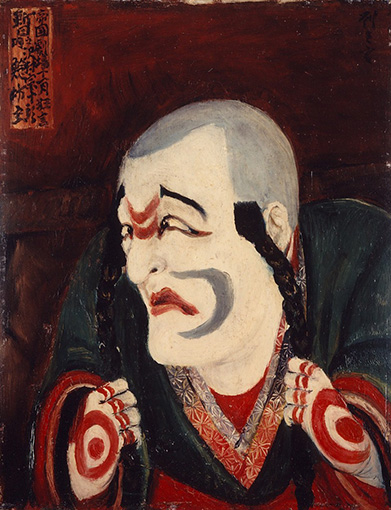
A man’s head juts out in a manner that closely resembles an actor portrait by the ukiyo-e artist Sharaku. The lively hands and face, the latter with white powder and dark makeup marks, make a mysterious impression from amid the gloomy background, creating a strong impact. “Namazu-bozu” is the name of the villain’s role in the kabuki program “Shibaraku,” a role that also involves a comedic performance. Kishida Ryusei was inspired to make this work by Sawamura Sojuro VII’s portrayal of Namazu-bozu. Several of Ryusei’s actor portraits remain, but this is the only example where a single actor’s head has been enlarged to fill the picture surface. Ryusei had appreciated ancient art since his first visit to Kyoto in 1919, and was strongly enamored with kabuki and ukiyo-e paintings. In accordance with these art forms, Ryusei’s own aesthetic expressed by the artist through his use term “derori.” Though it is difficult to define, this term has the sense of an overwhelming lifeforce, dripping like sweat, at once fascinating and repulsive. With the flat application of oil pigments and the restrained expression of shadow, this work is a perfect example of the derori aesthetic pursued by Ryusei.
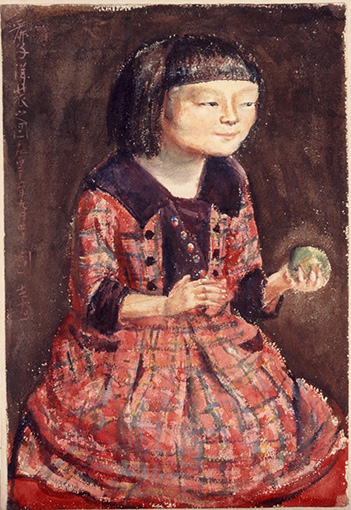
The seven-year-old Reiko is seated with a green apple in her hand. She is stylishly attired in a checkered red dress with decorative buttons and velvet sleeves. While her dainty hands retain a trace of infancy, her expression is somehow adult like. The real Reiko was an endearing young girl with almond-shaped eyes. However, this is not a painting that Ryusei made of his beloved daughter from his memory once she had grown up. Rather, through this “portrait of Reiko” Ryusei was attempting to deepen his use of the Western art aesthetic that he was interested in during this period. 1921 was also during the time when Ryusei was actively engaging with watercolor painting. Ryusei said that "the sudden expression of that beauty after coming to understand it thoroughly" is "a sense only achievable through watercolor", leaving behind works that make the best use of the special character of watercolor pigments. Reiko recollected that she was childishly pleased and proud to have been able to be useful to her father when being his model, even though it made her legs numb.
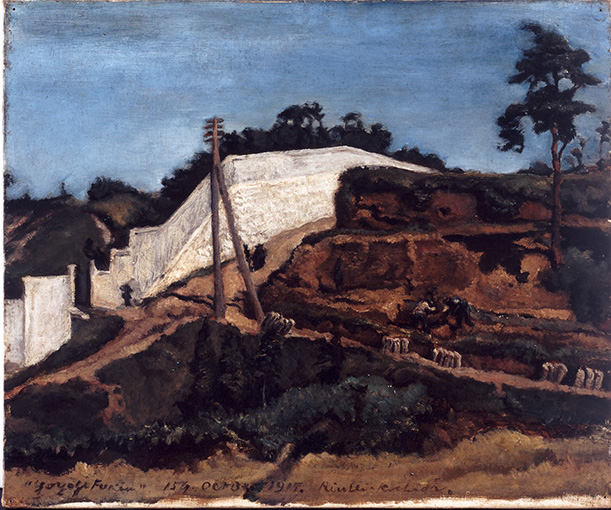
[Audio Guide]
In the lower half of the canvas, the undulating, exposed red clay soil is painted with a vivid sense of volume, resembling a living creature. The earth, the sky, the vegetation, the wall that cuts across them, and the colors of each element make a powerful impression. Workers on the right side of the picture and a telephone pole standing on the slope suggest that the site is being transformed into a residential district. A silhouette can be seen on the slope, which Ryusei wrote was “a self-portrait I added from imagination.” There also seem to be other people behind the telephone pole. In light of the fact that Ryusei’s beloved daughter Reiko was born the year before this work was painted, one imagines that it is the artist and his family. Around this time, Yoyogi, Tokyo under construction was a place that the artist loved and made the subject of many outstanding works. Among them, this painting rendered from a distance compellingly captures the hilly terrain in transition as the city expanded.
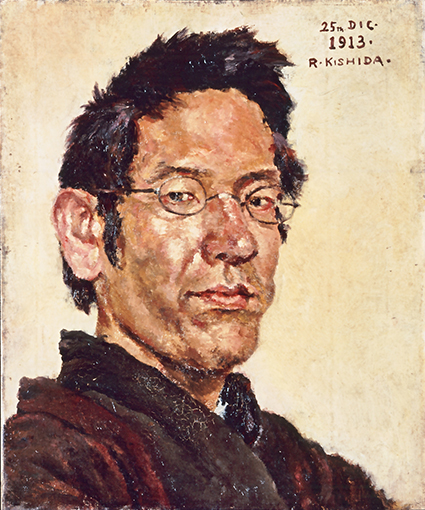
The subject is the twenty-two year old Kishida Ryusei himself, against a bright ochre background. A self-portrait, the work has been painted full of expressive power as the artist has attempted to capture the true nature of his target. Ryusei concentrated his efforts on self-portraits from 1913 until the following year, and also worked zealously on portraits of his wife and close friends. Accordingly, this is known as “Ryusei’s headhunting” period. Ryusei did not only sign his works, but also inscribed the date of completion on many of his paintings. By looking at his works in chronological order, we can see a dramatic change in his style over a short period around 1913. Transcending the abilities of an ordinary person, Ryusei’s furious powers of concentration and spirit of inquiry reveal his intent to reach his apogee as an artist. “25th.DIC・1913” is inscribed in the upper right of this work, from which we know that this painting was completed on Christmas Day, 1913.
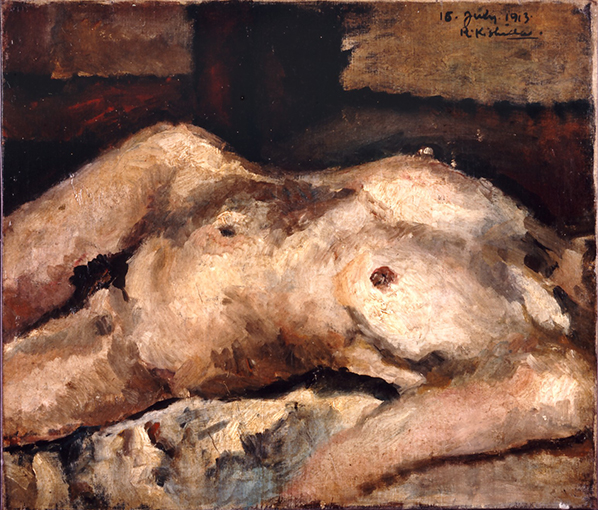
A reclining nude is shown from the neck to the knees, with brushwork that makes it appear as though the pigments have been applied with the artist’s fingers. While it resembles the body of a woman, without the head and hands we could also read this image as mountain foothills. Though the artist has depicted a torso, we understand their focus in the painting. Ryusei later recollected the following with regard to this period: “By confronting the subject with each and every brushstroke, this energy is assimilated into my heart. Once filled with this power, my heart leaps up and moves the brush. Rhythm, grappling with objects, reality—I was truly conscious of all of these things during that time.” At the age of twenty-two Ryusei was engaged in the attempt to transform his style from the pioneering methods of expression used at the time, influenced by figures such as Van Gogh, into a form of realism guided by Western classicism. The model was his wife Shigeru, whom he had recently married. The brushwork he used for her stomach resembles ploughed soil, and shortly afterwards she became pregnant with their daughter Reiko.